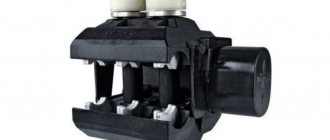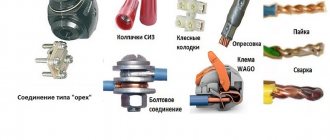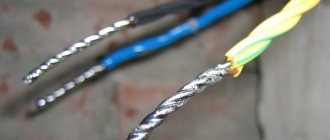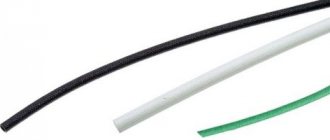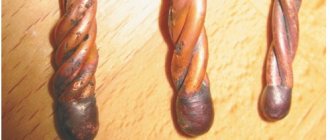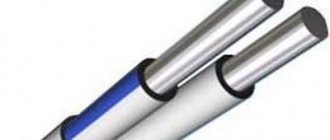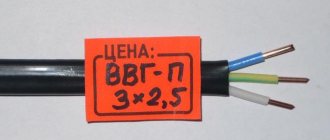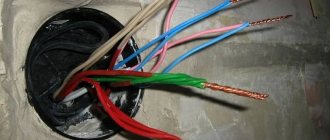The use of terminal clamps helps prevent premature corrosion on wires as a result of contact of materials with each other. Let's talk about what a collet clamp for wire is, what the features of its design are, and also consider the main types of terminal blocks widely used today.
So, most often electrical installation work is carried out using the following types of clamps to connect wires:
- screw;
- knife;
- spring
The vast majority of terminal blocks are made of brass; some of them are additionally filled with gel to prevent oxidation of the conductors.
What are screw terminal blocks?
Screw terminals are suitable for connecting electrical conductors of different materials with different diameters. The exception is stranded wires, which are crimped using special brass lugs.
You should also avoid combining aluminum conductors with screw-type clamps for cables and wires due to the latter’s insufficient mechanical strength. The clamping screw deforms the aluminum surface of the conductor, this must be taken into account.
Connection with bolts
To connect wires in this way, you need to have a bolt of the required size, a nut and several washers, which depends on the number of wires being connected. The connection is simple, affordable and very reliable.
Bolted wire connection
First of all, the wires are stripped to a metallic shine, after which a loop in the form of a ring is formed at the end of the wire without insulation, the diameter of which should be slightly larger than the diameter of the bolt. Forming such a ring is quite simple if you wrap the wire around the bolt and then tighten it. After the preparatory work, the connection process begins, which consists of the following operations:
- A washer is placed on the bolt.
- Then one of the guides is put on.
- After this, the second washer is put on.
- The second conductor is put on.
- The next washer is put on.
- The connection is securely twisted using a nut.
To make the connection reliable, the wires are twisted using tools in the form of keys for bolts. Electricians often use this type of connection, especially in industrial electrical networks where there is plenty of usable space. The main purpose is to connect copper and aluminum wires using a separating washer.
Products: advantages and installation rules
The most popular today are French-made “Legrand” screw terminal blocks. They are made of brass, plated with nickel. Their use ensures that the wire being connected retains its conductive properties.
The insulator is polypropylene, which can withstand temperatures from minus 25 degrees to plus 100 degrees Celsius. The material is resistant to open fire. Design features guarantee stable operation of the product throughout the service life declared by the manufacturer.
Advantages of Legrand terminal blocks:
- The design is characterized by high mechanical strength.
- An expanded range of standard sizes, which allows you to connect wires with a cross-section of up to 25 mm2.
- Can be used in low-current and power circuits in premises of any purpose.
- Variations in color schemes in terminal block insulation simplify the process of distinguishing wires and connections depending on their purpose.
- Control over the quality of products during the production process with testing at each stage, which is confirmed by product certificates.
It is worth noting that a reliable connection of wires using Legrand terminal blocks will only be possible if proper electrical installation is carried out. It is important to consider the following points:
- When connecting copper and aluminum wires using terminal products, it is necessary to prevent their contact in the cavity.
- When installing a connection using a terminal block in a junction box, care must be taken to eliminate stresses and mechanical loads that cause loosening of the contact.
- Every 10-12 months you need to check the connection, tightening it to the required voltage.
Connecting products must be installed according to the following algorithm:
- Strip the wire (the length should be equal to half the length of the metal busbar).
- Unscrew the clamping screw and install the conductor into the cavity of the terminal block.
- Tighten the clamping screw to ensure reliable contact of the terminal strip with the conductor.
Legrand products are sold in the form of a block consisting of 12 screw terminals with current and rated voltage indicators associated with the cross-section of the switched wire. For operation, the required number of terminals can be easily separated from the main unit using a knife.
The disadvantage of the products is the need for their annual maintenance.
Standard methods of connecting wires
Technically, wires can be connected using several methods, each of which has advantages and disadvantages in certain situations.
All of them are presented in the following table:
| Connection type, photo: | Short description: |
| Perhaps the simplest and most reliable method. Terminal blocks are mechanisms of various types of structure that clamp wires inside themselves, securely fixing them and ensuring stable switching. This point will be discussed in more detail as the article progresses. |
| In terms of connection reliability, the metal sleeve is much better than any of the terminals. It is a device consisting of a short tube made of tinned copper or a flat tip with a hole for mounting. In the middle of the standard sleeve there is a limiter that ensures that the wires are evenly immersed into the body of the tube on both sides. Installation is quite simple, but requires the use of a special crimper - crimper. The ends of the wires are inserted into the sleeve and then crimped around the edges, which allows you to create a very strong connection. The disadvantage of such a bond is that it is inseparable, plus the sleeve does not have its own insulation. Sleeves are also used where it is necessary to make a reliable screw connection. |
| A simple and extremely reliable connection that allows you to connect aluminum and copper wires to each other, provided that you use a metal that does not form a galvanic couple with the previously mentioned ones. Such a metal will be steel. Another good method is that the bolt can be used as a clamp for a large cross-section wire. However, it has many more disadvantages. Firstly, the design turns out to be too bulky, and it becomes unrealistic to fit it in a socket box or distribution box. Secondly, for insulation you have to wrap a lot of electrical tape on top, which also turns out to be bulky and low-tech. For this reason, they are used in large installation joints and, if necessary, to connect aluminum to copper. |
| Welded joints are rightfully the most reliable, since the metal is bonded at the molecular level, and the result is the lowest resistance. For such switching you will need a welding machine, which you also need to know how to handle. Welding is especially good when you need to tie together thick stranded conductors. There are also disadvantages - the connection is permanent, and the insulation is also performed separately. Using a welding machine at height is extremely inconvenient. There is a risk of melting the insulation, so only qualified specialists carry out such work, and it does not make much sense to consider the method as the main one for your home. Although if you hire a master, you can get confused. |
| Outwardly, soldering looks as reliable as welding, but in reality this is far from the case. This method is not applicable in high-voltage networks. The reason is that the metal used for soldering has a low melting point, which can cause the connection to “leak” under high loads. But in consumer electronics, soldering has no equal, as it is fast, convenient and reliable. |
| In principle, these devices can be classified as terminals, since they have their own insulation and differ only in the method of fixation. The photo shows caps with a coil spring that has pointed edges and tapers towards the end. The conductors are inserted inside and the cap is rotated clockwise until fully secured. The result is reliable and compact.
We'll talk more about the varieties later. |
| The easiest and fastest way to connect wires is to twist their bare ends. This method is still actively used even by professional electricians, which is why there is serious controversy. If we turn to the PUE standards, then in paragraph 2.1.21 you can read about methods of connecting wires, and twisting is not included in this list. Therefore, we can conclude that this method is officially prohibited. And there is an explanation for this:
Twisting is not a full-fledged detachable connection. Its use is justified as temporary, or for convenience when welding and soldering wires. |
Products: advantages and features
Unlike the products of the French company described above, the German products do not require regular maintenance. Spring screwless terminal blocks from this company allow you to achieve the most reliable connection of wires, regardless of their type and diameter.
The Wago tip has a number of advantages:
- The connection responds well to vibrations.
- Due to the constant pressure of the spring on the conductors, it is possible to create a permanent electrical resistance of the connection.
- Installing the products is simple and quick; no special tools are required.
- If necessary, multiple reconnections are possible while maintaining the current-carrying core.
- Open access of the tool taking measurements to the terminal block bus.
“Wago” terminal blocks are made from copper that has been tinned. This approach allows for an increase in the contact patch with a decrease in the electrical resistance of the connection and prevents oxidation of the conductor metals. Filling products with anti-corrosion lubricant is not excluded.
The design of Wago products can be presented in several versions:
- PUSH WIRE - suitable for permanent connections, characterized by a high level of spring stiffness.
- CAGE CLAMP - suitable for repeated connections, ideal for connecting flexible wires.
Mount the “Wago” terminal blocks on the wire in the following order:
- The wires are stripped taking into account the recess in the terminal body. This is approximately 10-13 mm.
- Install the conductor into the terminal block cavity using pliers.
The installation usually ends with testing the quality of the work.
Solder connection
To connect wires in this way, you need to master soldering technology. First of all, it is necessary to strip the wires, getting rid of unnecessary insulation, to a characteristic shine. It should be said right away that soldering aluminum wires is not so easy, so you shouldn’t even try to do it without special materials. As for copper, it can be soldered without problems. To ensure high-quality soldering, the ends of the wires stripped of insulation are tinned. To do this, they are heated with a soldering iron and applied to rosin. Rosin degreases the soldering area and the solder literally envelops the end of the conductor with a thin film. After this, the ends of the wires are twisted using pliers for reliability.
After this, you can begin the soldering process, which is the final stage. We can assume that the simplest thing left is to apply the required amount of solder to the twisted area using a heated soldering iron.
After cooling, if required by the technology, the soldering joints are treated with a special compound to get rid of excess rosin or flux, after which the joints are insulated using insulating tape or another method.
Connecting wires in a junction box
This option has both its advantages and disadvantages. Soldering is a fairly reliable method of connecting wires, as long as increased currents do not flow through the wires, leading to heating of the connection point. Since solder itself is a soft alloy, and its melting point is relatively low, when the joint is periodically heated, the solder seems to evaporate, which leads to weakening of the contact. If the problem is not detected in a timely manner, this can lead to overheating of the contact and fire of the insulation. It is not difficult to imagine what consequences await the electrical wiring, and at the same time the room in which it is laid. It is for this reason that electricians do not use this connection method, although there are other negative aspects.
A negative factor is weak mechanical strength, although it depends on how well and securely the wires are twisted. Considering the fact that the solder is relatively soft, then without any problems, by applying force, the soldering point can be weakened, which is the negative factor. As a rule, experienced electricians will not take responsibility for connecting wires in this way, and this process takes a lot of time.
What are knife terminal blocks?
Knife terminal blocks are used for switching wires in cases where, according to regulatory documents, the installation of a circuit must be carried out only using an unbroken current-carrying core. Typically, these requirements must be met by grounding and protective grounding circuits.
Installation of products in this case is possible without stripping the wires by directly installing them into the cavity of the terminal block, followed by crimping for strength. Knife-shaped contacts cut through the insulation layer, which guarantees safe contact.
Legrand is also a manufacturer of such products. Their products are most in demand today in the CIS countries.
What is a collet clamp and how does it work?
This clamp model allows you to avoid destruction of the wire joint during even prolonged use. The design is based on a body, two collets and the same number of nuts. A special feature of the body is a hexagonal stop in the middle part with cylindrical ends for mounting nuts.
This clamp option is suitable for connecting collet-type stranded wires. Its disadvantage is the inability to control the position of the wires in the collet, as well as the lack of fastening of the elements of the collet petals to each other, which provokes a decrease in the level of tensile load at the junction of the wires.
SIP piercing parts - use and composition
Piercing clamps for connecting SIP to bare wires allow you to avoid wasting time on insulation removal work. The installation process is quite simple and safe. The products are made of reinforced fiberglass and durable polymer. This choice of materials makes it possible to increase their resistance to UV rays and improves the sealing properties of the housing. Moisture will not damage the device even if contact is unavoidable, and this is a huge advantage.
There are several options for a clamp that performs a puncture for SIP wire:
- with one bolt;
- with two bolts.
The first option is also commonly called bare SIP. It is necessary for connecting bare wire to SIP. Its distinctive features include:
- cross-sectional indicators (from 16 to 95 mm2);
- quality polymer housing that can cope with the effects of atmospheric conditions;
- the presence of a stable bar.
Aluminum clamps are especially in demand to prevent corrosion during operation.
Piercing clamps with two bolts are needed to drain bare wires to the main line on the SIP. Sectional values can also reach 95 mm2. The product body is made of durable glass-reinforced polymer. The design feature is a lower bar for securing the key in the desired position. The product is resistant to weather conditions, so it will not let you down during operation.
The choice of a clamp for SIP should be dictated by the correspondence of the dimensions of the bolt head to the wrench. The 13 mm head is considered the most popular. The thickness of the main line can be judged by the size of the wire cross-section. From it you can draw conclusions about the size of the branch that will be installed in the clamp.
You can connect a self-supporting insulated wire to a bare main using:
- branch clamps;
- supportive;
- connecting;
- tension (aka anchor).
It would be correct to choose products from well-known, trusted brands to guarantee uninterrupted operation of power lines.
How to make the switch correctly
To achieve high quality contacts, it is important not only to choose the right clamps, but also to perform the switching correctly. Follow the recommendations below to avoid common mistakes:
- Strip the wires using a special tool that cannot damage the wire.
- Do not forget to remove the oxide film from the surface.
- Select the correct sleeve that allows you to perform high-quality compression.
- Make sure to insert the wire into the terminal block - it should go all the way to the insulating layer.
- Test the connection for strength.
- Allow a small margin of wire length for convenient installation to avoid mechanical loads on the terminal block.
- If you use a box with clamps, be sure to maintain a distance between them - this will help prevent a short circuit if they become heated.
Remember that, despite the fact that switching is a relatively safe and uncomplicated operation, work using wire clamps must be carried out exactly in accordance with the above rules. The reliability of switching will determine the level of characteristics of the electrical network, which, in turn, affect the stability of the operation of electrical appliances.
Connecting wires by crimping
An example of crimping conductors with a sleeve
To carry out such work, you will need a special sleeve. It is very important that the sleeve is made of the same metal as the conductor cores. Before placing the wire strands into the sleeve, they are cleaned to a shine, getting rid of the insulation. After this, a special tool is taken, with which the wires are clamped, ensuring reliable contact.
Both the tool and the sleeves are different, based on how many cores they can connect to each other at the same time. It is very important to choose the right tool and sleeves, otherwise the connection may not be reliable. It is for this reason that this method is also used in exceptional cases by professional electricians.
Crimping wires in the junction box. Crimping of wires in the junction box.
